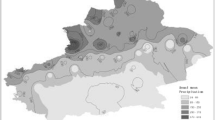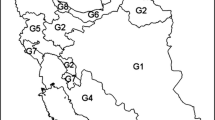Summary
Precipitation regionalization techniques alternatively advocated by Johnston [15] and Willmott [30] are reviewed and compared. An implementation by Johnston [15] of the information theory or entropy method was determined to have limited applicability —principally owing to its inability (1) to describe periodicies that are inherent in the seasonal cycle and (2) to account for differences between time-series of precipitation with respect to their means. The entropy method, however, has a practical appeal because the spatial distribution of stations has a relatively minor, deleterious impact on the regionalization [15]. On the other hand, the principal components-based procedure described by Willmott [30] includes more information about precipitation in the evaluation of regional patterns, e.g., station means, and it is well-able to characterize periodicities in the variance. With the appropriate experimental design, the combination of principal components analysis and grouping is regarded as superior to the entropy method in identifying and characterizing precipitation regimes and regions.
Zusammenfassung
Die von Johnston [15] und Willmott [30] vorgeschlagenen Methoden zur Berechnung des Gebietsniederschlages werden besprochen und miteinander verglichen. Eine Anwendung der Informationstheorie oder Entropiemethode, von Johnston [15] vorgeschlagen, besitzt nur beschränkte Möglichkeiten, hauptsächlich wegen der Unfähigkeit, 1. die im Jahresgang enthaltenen Periodizitäten zu beschreiben und 2. die Unterschiede zwischen den zeitlichen Reihen des Niederschlages und deren Mittelwerten zu erklären. Die Entropiemethode hat jedoch praktische Vorzüge, da die räumliche Verteilung der Stationen nur einen relativ geringen, ungünstigen Einfluss auf die Gebietswerte hat [15]. Die auf den Hauptkomponenten beruhenden Berechnungen von Willmott [30] beinhalten andererseits mehr Information über den Niederschlag in der Beurteilung der gebietsmässigen Verteilung, z.B. der Stationsmittelwerte, und ist gut in der Lage, Periodizitäten in der Varianz zu charakterisieren. Bei entsprechender Anwendung der Methoden ist eine Kombination von Hauptkomponentenanalyse und Gruppierungen der Entropiemethode bei der Charakterisierung von Niederschlagsregimen und -regionen überlegen.
Similar content being viewed by others
References
Anderson, T. W.: Asymptotic Theory for Principal Components Analysis. Ann. Math. Stat.34, 123–148 (1963).
Ayoade, J. O.: On the Use of Multivariate Techniques in Climatic Classification and Regionalization. Arch. Met. Geoph. Biokl., Ser. B24, 257–267 (1977).
Cattell, R. B.: The Scree Test for the Number of Factors. Multivariate Behavioral Res.1, 245–276 (1966).
Craddock, J. M.: Problems and Prospects for Eigenvector Analysis in Meteorology. The Statistician22, 133–145 (1973).
Daultrey, S.: Principal Components Analysis. Norwich: Geo Abstracts Ltd. 1976.
Davies, W. K. D.: Varimax and the Destruction of Generality. A Methodological Note. Area3, 112–118 (1971).
Davies, W. K. D.: Varimax and Generality: A Reply. Area3, 254–259 (1971).
Davies, W. K. D.: Varimax and Generality: A Second Reply. Area4, 207–208 (1972).
Dyer, T. G. J.: On the Components of Time Series; The Removal of Spatial Dependence. Quart. J. R. Met. Soc.102, 157–165 (1976).
Dyer, T. G. J.: The Assignment of Rainfall Stations Into Homogeneous Groups: An Application of Principal Components Analysis. Quart. J. R. Met. Soc.101, 1005–1013 (1975).
Gregory, S.: On the Delimitation of Regional Patterns of Recent Climatic Fluctuations. Weather30, 276–287 (1975).
IMSL (International Mathematical and Statistical Libraries, Inc.): IMSL Library 1, Edition 6, 1977 (FORTRAN IV) IBM S/270-360, Xerox Sigma S/6-7-9-11-560, Houston: IMSL, Inc.
Johnston, R. J.: Multivariate Statistical Analysis in Geography. New York: Longman Group Ltd. 1978.
Johnston, R. J.: Principal Components Analysis and Factor Analysis in Geographical Research: Some Problems and Issues. S. Afric. Geogr. J.59, 30–44 (1977).
Johnston, R. J.: Regarding the Delimitation of Regions According to Climatic Fluctuations. Arch. Met. Geoph. Biocl., Ser. B29, 215–228 (1981).
Kaiser, H. F.: The Varimax Criterion for Analytic Rotation in Factor Analysis. Psychometrika23, 187–200 (1958).
Karl, T. R., Koscielny, A. J., Diaz, H. F.: Potential Errors in the Application of Principal Component (Eigenvector) Analysis to Geophysical Data. J. Appl. Met.21, 1183–1186 (1982).
Koschmieder, H.: Methods and Results of Definite Rain Measurements. Mon. Weath. Rev.62, 5–7 (1934).
MacDonald, D. K. C.: Information Theory and its Application to Taxonomy. J. Appl. Phys.23, 529–531 (1952).
Mather, P. M.: Varimax and Generality: A Comment. Area3, 252–254 (1971).
Mather, P. M.: Varimax and Generality: A Second Comment. Area4, 27–30 (1972).
Morrison, D. F.: Multivariate Statistical Methods, 2nd ed. New York: McGraw-Hill 1976.
Richman, M. B.: Obliquely Rotated Principal Components: An Improved Meteorological Map Typing Technique? J. Appl. Met.20, 1145–1159 (1981).
Semple, R. K., Youngmann, C. E., Zeller, R. E.: Economic Regionalization and Information Theory: An Ohio Example. Discussion Paper 28, Department of Geography, Ohio State University, Columbus, Ohio, 1972.
Shih, S. F.: Rainfall Variation Analysis and Optimization of Gaging Systems. Water Res. Res.18, 1269–1277 (1982).
Walsh, J. A.: Information Theory and Classification in Geography. Discussion Paper 4, Department of Geography, McMaster University, Hamilton, Ontario, Canada, 1976.
Walsh, J. E., Richman, M. B., Allen, D. A.: Spatial Coherence of Monthly Precipitation in the United States. Mon. Weath. Rev.110, 272–286 (1982).
Ward, J. H., Jr.: Hierarchical Grouping to Optimize an Objective Function. J. Amer. Star. Ass.58, 236–244 (1963).
Willmott, C. J.: A Component Analytic Approach to Precipitation Regionalization in California. Arch. Met. Geoph. Biokl., Ser. B24, 269–281 (1977).
Willmott, C. J.: P-mode Principal Components Analysis, Grouping and Precipitation Regions in California. Arch. Met. Geoph. Biokl., Ser. B26, 277–295 (1978).
Willmott, C. J., Vernon, M. T.: Solar Climates of the Conterminous United States: A Preliminary Investigation. Solar Energy24, 295–302 (1980).
Wishart, D.: CLUSTAN 1C: User Manual. London: Univ. College Computer Center 1975.
Author information
Authors and Affiliations
Additional information
With 1 Figure
Rights and permissions
About this article
Cite this article
Legates, D.R., Willmott, C.J. A comparative evaluation of principal components-based and information theory methods of precipitation regionalization. Arch. Met. Geoph. Biocl., Ser. B 32, 381–394 (1983). https://doi.org/10.1007/BF02324658
Received:
Issue Date:
DOI: https://doi.org/10.1007/BF02324658




